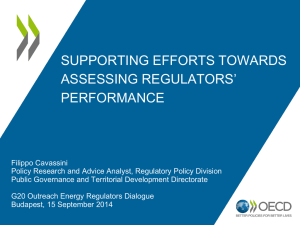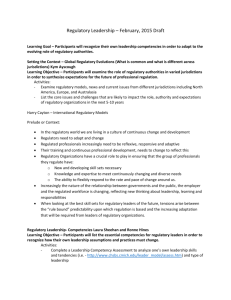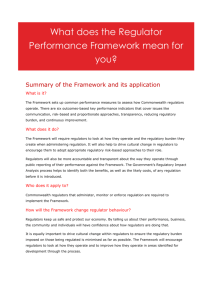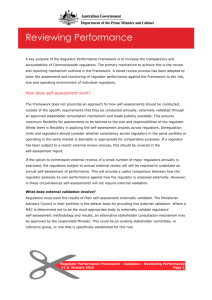Attachment 1 - Productivity Commission
advertisement
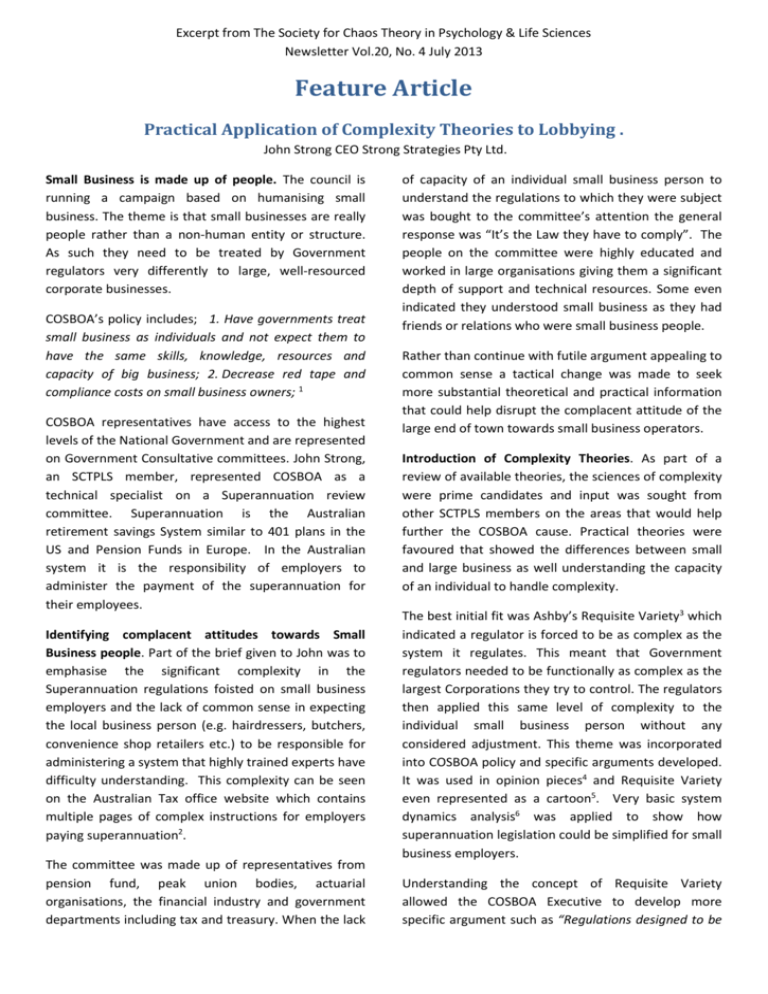
Excerpt from The Society for Chaos Theory in Psychology & Life Sciences Newsletter Vol.20, No. 4 July 2013 Feature Article Practical Application of Complexity Theories to Lobbying . John Strong CEO Strong Strategies Pty Ltd. Small Business is made up of people. The council is running a campaign based on humanising small business. The theme is that small businesses are really people rather than a non-human entity or structure. As such they need to be treated by Government regulators very differently to large, well-resourced corporate businesses. COSBOA’s policy includes; 1. Have governments treat small business as individuals and not expect them to have the same skills, knowledge, resources and capacity of big business; 2. Decrease red tape and compliance costs on small business owners; 1 COSBOA representatives have access to the highest levels of the National Government and are represented on Government Consultative committees. John Strong, an SCTPLS member, represented COSBOA as a technical specialist on a Superannuation review committee. Superannuation is the Australian retirement savings System similar to 401 plans in the US and Pension Funds in Europe. In the Australian system it is the responsibility of employers to administer the payment of the superannuation for their employees. Identifying complacent attitudes towards Small Business people. Part of the brief given to John was to emphasise the significant complexity in the Superannuation regulations foisted on small business employers and the lack of common sense in expecting the local business person (e.g. hairdressers, butchers, convenience shop retailers etc.) to be responsible for administering a system that highly trained experts have difficulty understanding. This complexity can be seen on the Australian Tax office website which contains multiple pages of complex instructions for employers paying superannuation2. The committee was made up of representatives from pension fund, peak union bodies, actuarial organisations, the financial industry and government departments including tax and treasury. When the lack of capacity of an individual small business person to understand the regulations to which they were subject was bought to the committee’s attention the general response was “It’s the Law they have to comply”. The people on the committee were highly educated and worked in large organisations giving them a significant depth of support and technical resources. Some even indicated they understood small business as they had friends or relations who were small business people. Rather than continue with futile argument appealing to common sense a tactical change was made to seek more substantial theoretical and practical information that could help disrupt the complacent attitude of the large end of town towards small business operators. Introduction of Complexity Theories. As part of a review of available theories, the sciences of complexity were prime candidates and input was sought from other SCTPLS members on the areas that would help further the COSBOA cause. Practical theories were favoured that showed the differences between small and large business as well understanding the capacity of an individual to handle complexity. The best initial fit was Ashby’s Requisite Variety3 which indicated a regulator is forced to be as complex as the system it regulates. This meant that Government regulators needed to be functionally as complex as the largest Corporations they try to control. The regulators then applied this same level of complexity to the individual small business person without any considered adjustment. This theme was incorporated into COSBOA policy and specific arguments developed. It was used in opinion pieces4 and Requisite Variety even represented as a cartoon5. Very basic system dynamics analysis6 was applied to show how superannuation legislation could be simplified for small business employers. Understanding the concept of Requisite Variety allowed the COSBOA Executive to develop more specific argument such as “Regulations designed to be understood by a fully staffed Human Resources department with access to legal counsel and institute trained accountants, cannot be understood easily by a hair dressing business”. Because the intended audience did not have a background in complexity sciences references to the actual underlying theories were simplified to sound bites such as “Systems Management Theory” rather than refer to Cybernetics, Game Theory or other Complexity theories. An In Depth Review Announced. The executive of COSBOA continued to lobby hard for regulators to take into account the lack of capacity of a small business person to understand complex regulations. This paid off with the Australian Productivity Commission instructed to investigate the best practice behaviours of Regulators towards small business7. The Australian Productivity Commission is “the Australian Government's independent research and advisory body on a range of economic, social and environmental issues affecting the welfare of Australians.”8. In its terms of reference document9 the Commission noted that there are 1100 Regulators covering a vast array of regulations from food laws through to financial services. The Commission is a fully resourced research unit with access to advisers of the highest calibre in technical and scientific training. This presented an opportunity to introduce more fully referenced and technical arguments on the effect of legislative complexity on a small business person. Two submissions were prepared, one by COSBOA following their own policy agenda10 and one by John Strong exploring the application of complexity sciences. That submission11 introduced references to complexity and behavioural psychology theories that illustrated the argument of unmanageable complexity. Due to time constraints and the pro bono nature of the work this submission was written quickly over a forty eight hour period. The rest of this article explores the arguments made in that submission. The System Grooms the Regulator. The opening argument identified “business” as a complex adaptive system12 and reasoned that therefore a regulator had to be a model (reflective fractal?) of the system it regulated13. This meant that a regulator develops a culture that was equivalent to a large complex corporation. In the paper this was presented as the system grooming the regulator’s structure. In exploring the interaction of a large corporation and a government regulator it was argued that the corporation’s internal hierarchy of managers provided layers of protection that kept the productive employees buffered away from direct interference from a regulator’s actions. The interaction between the regulators and small business was then addressed and it was noted that the regulator now had a task of interacting with two million small business people compared to eighty seven thousand medium to large businesses. This is an increase of 2300% in potential interactions and raised the complexity for the regulator significantly. As a result of a regulator being groomed to act like a large business and faced with the daunting task of handling such a large number of individuals the response of a regulator is to consider all businesses as if they were large businesses and treat them all the same. It was highlighted that each small business did not have the layers of management protection between the regulator and the person making the income in a small businesses. This meant that the actions of a regulator could easily disrupt the income of a small business and threaten its viability more quickly than the better protected large businesses. Delusionally Optimistic Small Business People. The point of view a small business was then investigated and the fact was noted that a small business person was in effect alone with little support and potentially facing eleven hundred regulators who may try and control their behaviour. The non-linear nature of this interaction was examined, however the true potential for a chaotic outcome from such an unbalanced network was not investigated due to time constraints and the lack of access to experts in this area who could properly express that concept. Given this obviously overwhelming lack of capacity of an individual to understand and meet Government regulator’s requirements it was argued that Small Business people suffer from delusional optimism14 to enable them to operate within the system. The ability of humans to apply selective attention in situations of cognitive overload15 was referenced and used to explain how small business actually work within this system by ignoring most of the regulations until they are proved to be important. The potential outcome of depression when such optimism breaks down was then raised. The fact that employees have legislated protections from the stress of working in an overly complex environment but the employer doesn’t, was emphasised. In line with the warnings of regulators potentially being part of the cause of depression, the Stanford prisoner/guard experiment16 and Janet Elliot’s Blue eye Brown Eye17 work was bought to the Productivity Commission’s attention to emphasise the need for nuanced application of a regulator’s authority. Shadow Regulators. The ability for other larger business entities to cause quick and dramatic effects in changing business rules was canvassed through practical examples and reference to personal experience. This introduced an aspect of Network theory to the argument. A shadow regulator was defined as a large and influential business entity which could demand changes to business rules in a network with little warning and potentially drastic consequences to the smallest players in the business world. An example of an Insurer who threatened to withdraw insurance cover unless a specific change was made to business practices was used to illustrate this point. This was bought to the Productivity Commission’s attention because some of the official regulators were responsible for regulating competition policy and contract rules and had a duty to ensure these shadow regulators played fair. Recommendations. The submission paper then addressed the best practice options for regulators dealing with small business. Formalise a Guild System. The first recommendation was to look at the current system for what was working. The ancient guild system was identified as a strategy that has evolved within the ecosystem of business and government interactions to control the potential for a breakout of chaotic behaviour. It was suggested that this system be formalised to place small business into categories. Guilds or in more modern parlance Business Associations are already recognised and consulted by regulators. This presents an opportunity to reduce complexity using these categories to be more specific in legislating business behaviour. This would more closely match the current system where regulators are structured to deal with larger organisations. This would bring the two systems closer together. Discussions with COSBOA executives determined that such guilds should be favoured by legislation but not mandatory so that a competitive and dynamic business environment is maintained. Systems Dynamics. A second recommendation was to apply systems dynamics analysis to specific regulations to understand how they were actually working rather than just assume they were working. An excellent paper by Tim Haslett18 was referenced where this had been carried out within the Australian Tax Office specifically on Superannuation. The opportunity through using this method to understand the actual drivers of the system and be more specific in regulations rather than write all-encompassing legislation was emphasised. A specific technique that could be seen as having aspects of system dynamics analysis was commented upon, this being a risk based outcome oriented approach to food regulation called Hazard Analysis and Critical Control Points. A subsequent submission by one Australian food safety regulator expanded on this process19 . It is to be noted that several other submissions called for the application of risk based outcome oriented approaches. Behavioural Psychology and Cheating. Another recommendation referenced the programme initiated by the British Cabinet Office20 which formed a “Behavioural Insights” team to understand and utilise behavioural psychology in applying regulations. A recommendation was made for regulators to look at behavioural psychology to help regulate small business rather than only concentrate on punishing miscreants. The paper canvassed the difference of being treated as a potential miscreant vs being advised of the expected behaviour. This was illustrated in the submission via logical argument however subsequent to the submission the author sourced an excellent reference from Francesca Gino’s book “Sidetracked”21. In the introduction to that book Francesca shows how people were more likely to cheat if they had the impression they were wearing fake designer sunglasses than if they thought they were wearing authentic glasses. This emphasised the opportunity for regulators to lower noncompliance by defining and promoting good behaviour rather than concentrating on legislating and regulating everyone as if they are potential miscreants. Knowing you are a potential miscreant is akin to wearing fake sunglasses and therefore subconsciously you are expected to cheat. In the authors experience this theme can be expressed as promoting the concept of stewardship rather than accepting a culture of entitlement. Ongoing: The Commission investigation is still in the early stages as of the writing of this paper. Their final report is not due until September. improvisation, Performance Improvement Quarterly, 20(2), 21-42. 13 Conant, Roger C, W. Ashby, Ross. Every good regulator of a system must be a model of that system. Int. J. Systems Sci., 1970, vol. 1, No. 2, 89-97 14 Weinstein, Neil D. “Unrealistic optimism about future life events”. Journal of Personality and Social Psychology, Vol 39(5), Nov 1980, 806-820 15 Peng Liu, Zhizhong Li “Task complexity: A review and conceptualization framework”. International Journal of Industrial Ergonomics Volume 42, Issue 6, November 2012, Pages 553–568 16 http://www.prisonexp.org/ 17 Bloom, Stephen G (September 2005). "Lesson of a Lifetime". Smithsonian Magazine 18 Haslett, T. & Sarah, R. (2006). Mapping and Modeling in the Australian Taxation Office: A Case Study. Systemic Practice and Action Research 19, (3) p. 273 – 307 19 http://www.pc.gov.au/__data/assets/pdf_file/0017/122552 /sub028-small-business.pdf 20 Acknowledgements: The author would like to acknowledge and thank Stephen Guastello and Tim Haslett for their help and guidance in advising on different approaches to incorporating complexity theories into this work. 1 http://www.cosboa.org.au/Page/COSBOA-Policy 2 http://www.ato.gov.au/businesses/pathway.aspx?pc=001/0 03/090 3 “Law of Requisite Variety” Chapter 11 p 206. W. Ross Ashby (1956): An Introduction to Cybernetics, (Chapman & Hall, London) available electronically at http://pespmc1.vub.ac.be/ASHBBOOK.html and http://pespmc1.vub.ac.be/books/IntroCyb.pdf) 4 http://www.cosboa.org.au/Post/SimplicityinLegislationCreat esProductivity 5 http://www.cosboa.org.au/Post/Isthereaseachangeintheway smallbusinessisviewedandtreated 6 http://www.strongs.biz/Portals/105/Transcape/Compare%2 0the%20pair%20+.pdf 7 http://www.pc.gov.au/projects/study/small-business 8 http://www.pc.gov.au/about-us/quick-guide 9 http://www.pc.gov.au/__data/assets/pdf_file/0006/121677 /small-business-issues.pdf 10 http://www.pc.gov.au/__data/assets/pdf_file/0017/122444 /sub015-small-business.pdf 11 http://www.pc.gov.au/__data/assets/pdf_file/0003/122466 /sub019-small-business.pdf 12 McDaniel, Reuben R., Jr. (2007). Management strategies for complex adaptive systems: Sensemaking, learning, and https://www.gov.uk/government/organisations/behaviou ral-insights-team 21 Gino, Francesca (2013-02-12). Sidetracked: Why Our Decisions Get Derailed, and How We Can Stick to the Plan (p. 199). Harvard Business Review Press. Kindle Edition.


